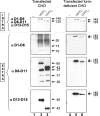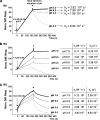LEKTI fragments specifically inhibit KLK5, KLK7, and KLK14 and control desquamation through a pH-dependent interaction
- PMID: 17596512
- PMCID: PMC1951746
- DOI: 10.1091/mbc.e07-02-0124
LEKTI fragments specifically inhibit KLK5, KLK7, and KLK14 and control desquamation through a pH-dependent interaction
Abstract
LEKTI is a 15-domain serine proteinase inhibitor whose defective expression underlies the severe autosomal recessive ichthyosiform skin disease, Netherton syndrome. Here, we show that LEKTI is produced as a precursor rapidly cleaved by furin, generating a variety of single or multidomain LEKTI fragments secreted in cultured keratinocytes and in the epidermis. The identity of these biological fragments (D1, D5, D6, D8-D11, and D9-D15) was inferred from biochemical analysis, using a panel of LEKTI antibodies. The functional inhibitory capacity of each fragment was tested on a panel of serine proteases. All LEKTI fragments, except D1, showed specific and differential inhibition of human kallikreins 5, 7, and 14. The strongest inhibition was observed with D8-D11, toward KLK5. Kinetics analysis revealed that this interaction is rapid and irreversible, reflecting an extremely tight binding complex. We demonstrated that pH variations govern this interaction, leading to the release of active KLK5 from the complex at acidic pH. These results identify KLK5, a key actor of the desquamation process, as the major target of LEKTI. They disclose a new mechanism of skin homeostasis by which the epidermal pH gradient allows precisely regulated KLK5 activity and corneodesmosomal cleavage in the most superficial layers of the stratum corneum.
Figures









Similar articles
-
Identification of lympho-epithelial Kazal-type inhibitor 2 in human skin as a kallikrein-related peptidase 5-specific protease inhibitor.PLoS One. 2009;4(2):e4372. doi: 10.1371/journal.pone.0004372. Epub 2009 Feb 3. PLoS One. 2009. PMID: 19190773 Free PMC article.
-
A potential role for multiple tissue kallikrein serine proteases in epidermal desquamation.J Biol Chem. 2007 Feb 9;282(6):3640-52. doi: 10.1074/jbc.M607567200. Epub 2006 Dec 11. J Biol Chem. 2007. PMID: 17158887
-
LEKTI domains D6, D7 and D8+9 serve as substrates for transglutaminase 1: implications for targeted therapy of Netherton syndrome.Br J Dermatol. 2019 Nov;181(5):999-1008. doi: 10.1111/bjd.17820. Epub 2019 Jun 6. Br J Dermatol. 2019. PMID: 30801672
-
LEKTI-1 in sickness and in health.Int J Cosmet Sci. 2009 Aug;31(4):247-54. doi: 10.1111/j.1468-2494.2009.00516.x. Epub 2009 May 13. Int J Cosmet Sci. 2009. PMID: 19467033 Review.
-
Netherton syndrome: skin inflammation and allergy by loss of protease inhibition.Cell Tissue Res. 2013 Feb;351(2):289-300. doi: 10.1007/s00441-013-1558-1. Epub 2013 Jan 24. Cell Tissue Res. 2013. PMID: 23344365 Review.
Cited by
-
Unleashing the therapeutic potential of human kallikrein-related serine proteases.Nat Rev Drug Discov. 2015 Mar;14(3):183-202. doi: 10.1038/nrd4534. Epub 2015 Feb 20. Nat Rev Drug Discov. 2015. PMID: 25698643 Review.
-
Remodelling of the tumour microenvironment by the kallikrein-related peptidases.Nat Rev Cancer. 2022 Apr;22(4):223-238. doi: 10.1038/s41568-021-00436-z. Epub 2022 Jan 31. Nat Rev Cancer. 2022. PMID: 35102281 Review.
-
Protease and protease-activated receptor-2 signaling in the pathogenesis of atopic dermatitis.Yonsei Med J. 2010 Nov;51(6):808-22. doi: 10.3349/ymj.2010.51.6.808. Yonsei Med J. 2010. PMID: 20879045 Free PMC article. Review.
-
Metformin inhibits melanoma cell metastasis by suppressing the miR-5100/SPINK5/STAT3 axis.Cell Mol Biol Lett. 2022 Jun 15;27(1):48. doi: 10.1186/s11658-022-00353-5. Cell Mol Biol Lett. 2022. PMID: 35705923 Free PMC article.
-
Genetic activation of Nrf2 reduces cutaneous symptoms in a murine model of Netherton syndrome.Dis Model Mech. 2020 Jun 1;13(5):dmm042648. doi: 10.1242/dmm.042648. Dis Model Mech. 2020. PMID: 32457102 Free PMC article.
References
-
- Ahmed A., Kandola P., Ziada G., Parenteau N. Purification and partial amino acid sequence of proteins from human epidermal keratinocyte conditioned medium. J. Protein Chem. 2001;20:273–278. - PubMed
-
- Bitoun E., et al. LEKTI proteolytic processing in human primary keratinocytes, tissue distribution and defective expression in Netherton syndrome. Hum. Mol. Genet. 2003;12:2417–2430. - PubMed
-
- Brattsand M., Stefansson K., Lundh C., Haasum Y., Egelrud T. A proteolytic cascade of kallikreins in the stratum corneum. J. Invest. Dermatol. 2005;124:198–203. - PubMed
-
- Caubet C., Jonca N., Brattsand M., Guerrin M., Bernard D., Schmidt R., Egelrud T., Simon M., Serre G. Degradation of corneodesmosome proteins by two serine proteases of the kallikrein family, SCTE/KLK5/hK5 and SCCE/KLK7/hK7. J. Invest. Dermatol. 2004;122:1235–1244. - PubMed
-
- Chavanas S., et al. Mutations in SPINK5, encoding a serine protease inhibitor, cause netherton syndrome. Nat. Genet. 2000;25:141–142. - PubMed
Publication types
MeSH terms
Substances
LinkOut - more resources
Full Text Sources
Other Literature Sources
Molecular Biology Databases
Miscellaneous

